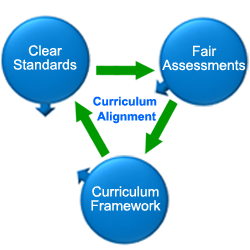Defining a Curriculum
Ideally, a curriculum should lay the foundation for instruction from grade level to grade level. Similarly, it should provide both students and teachers a clear vision of the knowledge and skills that need to be acquired during an instructional period of time. In other words, a defined curriculum is essentially a roadmap that communicates the direction and final destinations that students must arrive at. Wiggins and McTighe convey, “Curriculum refers to the specific blueprint for learning and is derived from content and performance standards.” Curriculum Frameworks located within SAS accomplish exactly this. They identify the instructional content that may be taught for every subject area and grade level in Pennsylvania. In addition, the Big Ideas, Essential Questions, Concepts, Competencies, and Eligible Content all align to the academic Standards. Ultimately, all of the components of a robust curriculum are aligned and interconnected with one another.
Below are some essential characteristics of what a curriculum should be comprised of:
- Curriculum should focus on powerful knowledge.
- All students should experience a thinking curriculum.
- The best results come from having an aligned curriculum.

